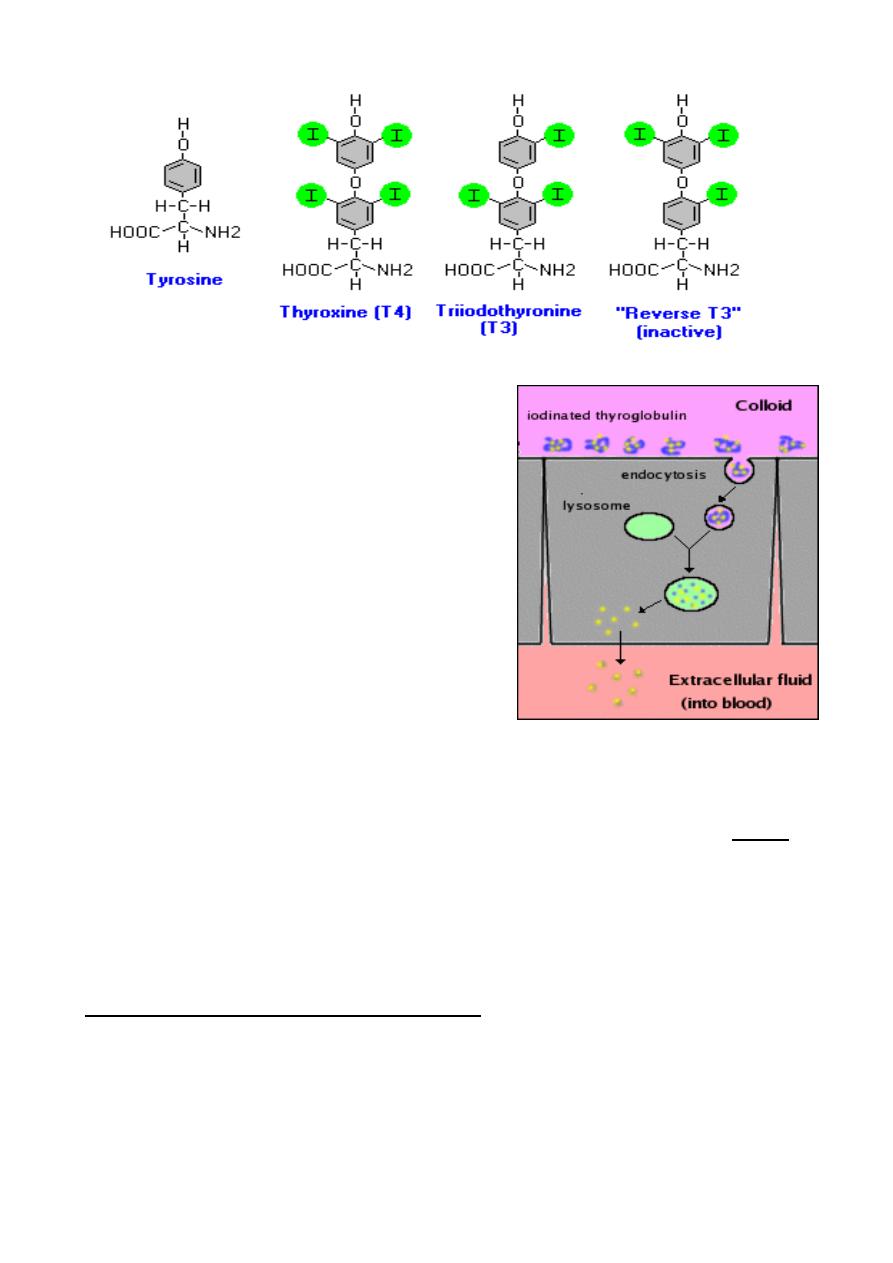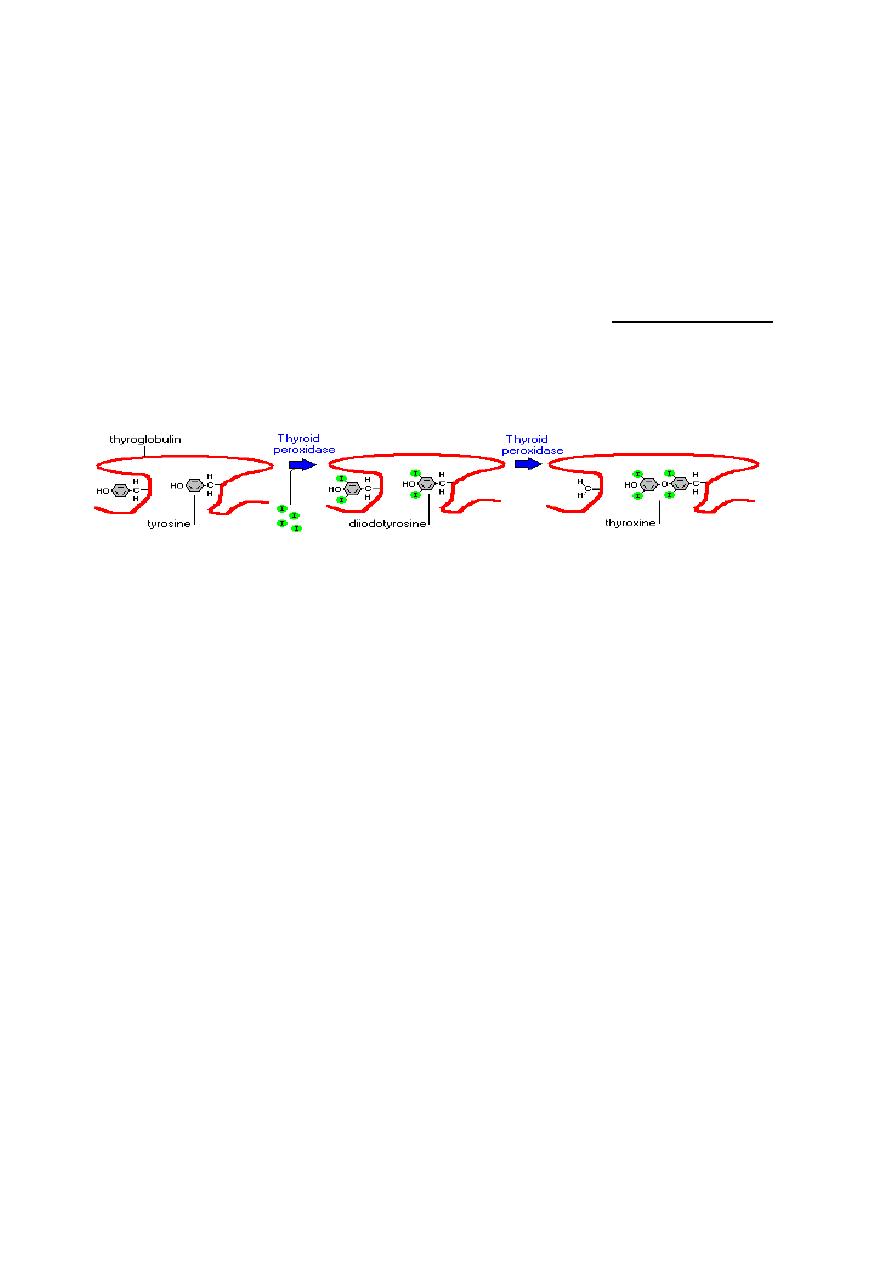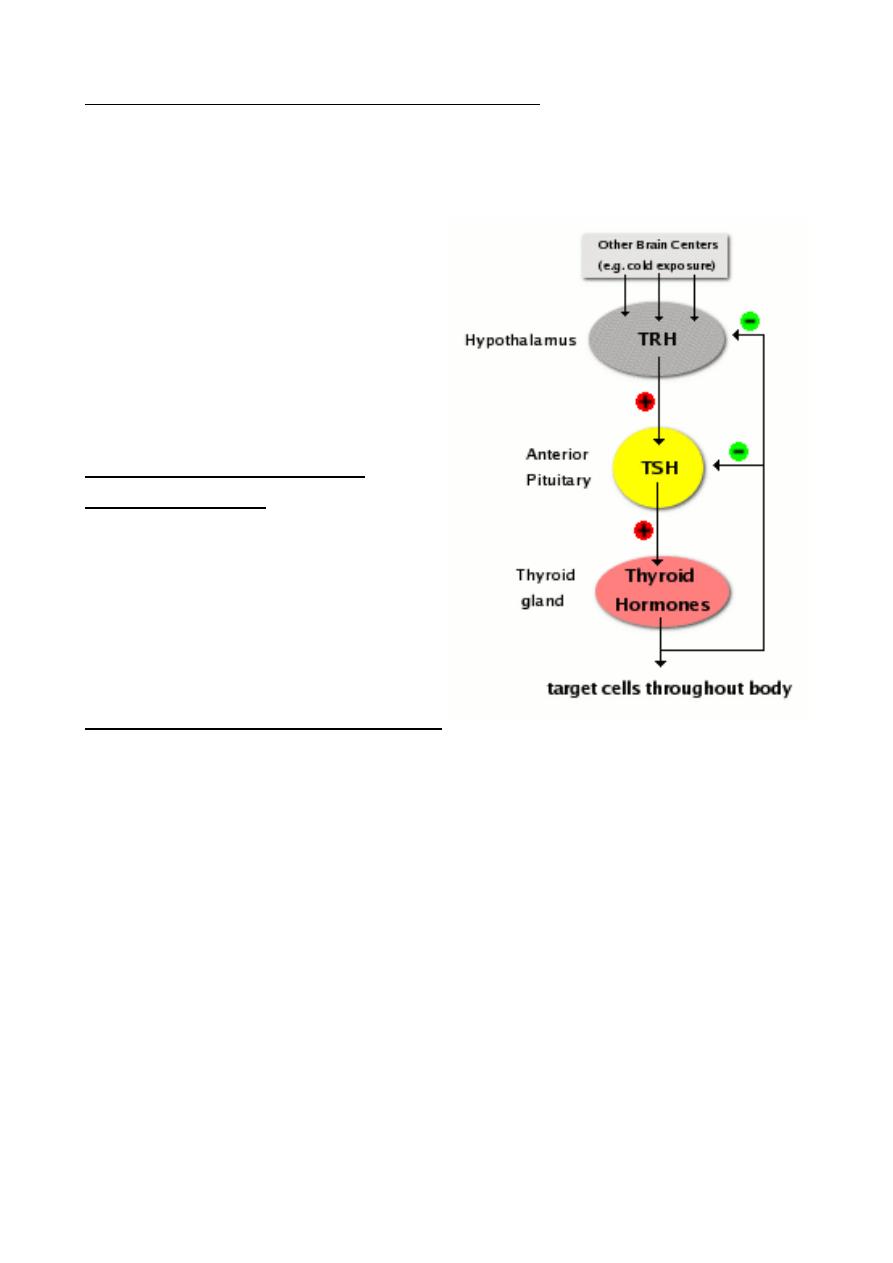
Prof. Dr. Hedef Dhafir El-Yassin
2014
1
Lecture 5
Biochemistry and Disorder of Hormones of the
Thyroid Gland
Objectives:
1. to list the hormones synthesized by the thyroid gland and state their functions
2. to describe synthesis , regulation, and metabolism of thyroid hormones
3. to state the effects of increased and decreased concentrations of thyroid hormones
on TSH concentrations.
4. to understand the disorders of the thyroid and the associated diseases such as :
a. Hashimoto disease
b. Graves disease
c. Secondary hypothyroidism
d. Thyroid antibodies
Case (1): A 19- year-old patient visited the physician office complaining of weight loss,
nervousness, sleeplessness, heart palpitations and irregular menstrual cycle.
Her physical examination showed she had a noticeable tremor in her hands, underweight,
her BP was 160/85, she had a wide
–eyed stare and her lower neck was full. The
physician suspected thyrotoxicosis or increased circulating levels of thyroid hormones.
However, it was unclear from the available information why her thyroid hormone levels
were elevated. Lab tests were performed to determine the etiology of her condition:
Total T4
increased
Free T4
increased
TSH
decreased (undetectable)
1. The physician considered the following possible causes of thyrotoxicosis, based on his
understanding of the hypothalamic-anterior pituitary-thyroid axis:
a. Increased secretion of TRH from the hypothalamus
b. Increased secretion of TSH from anterior pituitary
c. Primary hyperactivity of the thyroid gland (e.g. Graves disease)
d. Ingestion of exogenous thyroid hormones.
Using the laboratory findings and your knowledge of the regulation of thyroid
hormone secretion, include or exclude each of the four potential causes of the
patient's thyrotoxicosis.
2. The physician performed a radioactive I
-
uptake test to measure the activity of the
patient's thyroid gland. When her thyroid was scanned for radioactivity, I
-
was
increased uniformly throughout the gland. How did this additional information help
refine the diagnosis? Which potential cause of thyrotoxicosis discussed in the above
question was ruled out by this result?

Prof. Dr. Hedef Dhafir El-Yassin
2014
2
Thyroid Hormones
The thyroid gland secretes thyroxine and smaller amounts of triiodothyronine (T3),
which stimulate oxidative respiration in most cells in the body and, in so doing,
help set the body’s basal metabolic rate.
In children, these thyroid hormones also promote growth and stimulate
maturation of the central nervous system.
o Children with underactive thyroid glands are therefore stunted in their growth
and suffer severe mental retardation, a condition called cretinism. This differs
from pituitary dwarfism, which results from inadequate GH and is not
associated with abnormal intellectual development.
People who are hypothyroid (whose secretion of thyroxine is too low) can take
thyroxine orally, as pills. Only thyroxine and the steroid hormones (as in
contraceptive pills), can be taken orally because they are nonpolar and can pass
through the plasma membranes of intestinal epithelial cells without being digested.
The thyroid gland also secretes calcitonin, a peptide hormone that plays a role in
maintaining proper levels of calcium (Ca++) in the blood. When the blood Ca++
concentration rises too high, calcitonin stimulates the uptake of Ca++ into bones,
thus lowering its level in the blood.
1. Thyroxin (T4) and triiodotyonine T3
Biochemistry of Thyroid Hormones
Thyroid hormones are derivatives of the amino acid tyrosine bound covalently to iodine.
The two principal thyroid hormones are:
thyroxine (T
4
or L-3,5,3',5'-tetraiodothyronine)
triiodotyronine (T
3
or L-3,5,3'-triiodothyronine).
Thyroid hormones are basically two tyrosines linked together with the critical
addition of iodine at three or four positions on the aromatic rings. The number and
position of the iodines is important. Several other iodinated molecules are generated that
have little or no biological activity; so called "reverse T
3
"

Prof. Dr. Hedef Dhafir El-Yassin
2014
3
A large majority of the thyroid hormone secreted from the thyroid gland is T
4
, but T
3
is the considerably more active hormone.
Although some T
3
is also secreted, the bulk of the
T
3
is derived by deiodination of T
4
in peripheral
tissues, especially liver and kidney. Deiodination of
T
4
also yields reverse T
3
, a molecule with no known
metabolic activity.
Thyroid hormones are poorly soluble in water, and
more than 99% of the T
3
and T
4
circulating in blood
is bound to carrier proteins. The principle carrier of
thyroid hormones is thyroxine-binding globulin, a
glycoprotein synthesized in the liver. Another
carrier is albumin.
Quick quiz: The characteristic features of active form of thyroid hormone are all except:
1. T3 is 4 times active than T4
2. T4 acts as a pro-hormone to T3
3. 80% of T3 is converted in circulation to T4
4. T3 is 10 times active at binding of receptors
Synthesis and Secretion of Thyroid Hormones
The entire synthetic process occurs in three major steps:
Production and accumulation of the raw materials
Fabrication or synthesis of the hormones on a backbone or scaffold of precursor
Release of the free hormones from the scaffold and secretion into blood

Prof. Dr. Hedef Dhafir El-Yassin
2014
4
Raw materials:
Tyrosines are provided from a large glycoprotein scaffold called thyroglobulin,. A
molecule of thyroglobulin contains 134 tyrosines, although only a handful of these are
actually used to synthesize T
4
and T
3
.
Iodine, or more accurately iodide (I
-
), is taken up from blood by thyroid epithelial cells,
which have on their outer plasma membrane an "iodine trap". Once inside the cell,
iodide is transported into the lumen of the follicle along with thyroglobulin.
Fabrication of thyroid hormones is conducted by the enzyme thyroid peroxidase,
Thyroid peroxidase catalyzes two sequential reactions:
1. Iodination of tyrosines on thyroglobulin (also known as "organification of iodide").
2. Synthesis of thyroxine or triiodothyronine from two iodotyrosines.
Thyroid hormones are excised from their thyroglobulin scaffold by digestion in
lysosomes of thyroid epithelial cells. Free thyroid hormones apparently diffuse out of
lysosomes, through the basal plasma membrane of the cell, and into blood where they
quickly bind to carrier proteins for transport to target cells.
Quick quiz:
Which of the following statement is true regarding thyroid peroxidase?
1. Free tyrosine in thyroid gland
2. It iodinates tyrosine residues in thyroxin binding globulin
3. It iodinates tyrosine residues in thyroxin binding prealbumn;
4. It iodinates tyrosine residues in thyroglobulin

Prof. Dr. Hedef Dhafir El-Yassin
2014
5
Control of Thyroid Hormone Synthesis and Secretion
Each of the processes described above appears to be stimulated by thyroid-stimulating
hormone from the anterior pituitary gland. Binding of TSH to its receptors on thyroid
epithelial cells stimulates synthesis of the iodine transporter, thyroid peroxidase and
thyroglobulin. When TSH levels are low, rates
of thyroid hormone synthesis and release
diminish.
The thyroid gland is part of the hypothalamic-
pituitary-thyroid axis, and control of thyroid
hormone secretion is exerted by classical
negative feedback.
Thyroid Hormone Receptors and
Mechanism of Action
Receptors for thyroid hormones are
intracellular DNA-binding proteins that
function as hormone-responsive
transcription factors, very similar
conceptually to the receptors for steroid
Metabolic Effects of Thyroid Hormones
Thyroid hormones have profound effects on many physiologic processes, such as
development, growth and metabolism. They stimulate diverse metabolic activities
most tissues, leading to an increase in basal metabolic rate. One consequence of
this activity is to increase body heat production, which seems to result, at least in
part, from increased oxygen consumption and rates of ATP hydrolysis. A few
examples of specific metabolic effects of thyroid hormones include:
Lipid metabolism: Increased thyroid hormone levels stimulate fat
mobilization, leading to increased concentrations of fatty acids in plasma. They
also enhance oxidation of fatty acids in many tissues. Finally, plasma
concentrations of cholesterol and triglycerides are inversely correlated with
thyroid hormone levels - one diagnostic indication of hypothyroidism is
increased blood cholesterol concentration.

Prof. Dr. Hedef Dhafir El-Yassin
2014
6
Carbohydrate metabolism: Thyroid hormones stimulate almost all aspects of
carbohydrate metabolism, including enhancement of insulin-dependent entry of
glucose into cells and increased gluconeogenesis and glycogenolysis to
generate free glucose.
Other Effects: A few additional, effects of thyroid hormones include:
On muscle: T3 increases glucose uptake by muscle cells it also stimulate
protein synthesis and therefore growth of muscle through its stimulatory
actions on gene expression. Thyroid hormone sensitizes the muscle cell to the
glycogenolytic actions of epinephrine. Glycolysis in muscle is increased by
this action of T
3
.
On the pancreas: thyroid hormone increases the sensitivity of the
cells of
the pancreas to those stimuli that normally promote insulin release and is
required for optimal insulin secretion
On Cardiovascular system: Thyroid hormones increases heart rate, cardiac
contractility and cardiac output. They also promote vasodilation, which leads
to enhanced blood flow to many organs.
On Central nervous system: Both decreased and increased concentrations of
thyroid hormones lead to alterations in mental state. Too little thyroid
hormone, and the individual tends to feel mentally sluggish, while too much
induces anxiety and nervousness.
On Reproductive system: Normal reproductive behavior and physiology is
dependent on having essentially normal levels of thyroid hormone.
Hypothyroidism in particular is commonly associated with infertility.

Prof. Dr. Hedef Dhafir El-Yassin
2014
7
Thyroid Disease States
1. Hypothyroidism : a deficiency in thyroid hormone secretion and action
a. Primary: the synthesis of T4 and T3 is impaired due to one or more of
the following:
i. Loss of functional tissue
ii. Infiltrative disease o the thyroid
iii. Defects in the thyroid hormone synthesis
iv. Idiopathic (TSH receptor defect)
v. Thyroditis with auto-antibodies
b. Secondary: (central) occurs as a result of pituitary or hypothalamic
disease that produce a deficiency in TSH, TRH or both.
2. Hyperthyroidism (thyrotoxicosis): a hyper-metabolic condition caused by
excessive production of thyroid hormones. Causes are divided into:
a. Those that are associated with clinically evident hyperthyroidism and
increased production and secretion of thyroid hormones from the gland:
i. . Graves's disease: development of IgG antibody against the
thyroid TSH receptor resulting n overproduction of T4 and T3.
ii. Autonomous production by thyroid nodules
iii. A toxic solitary edema
iv. Excessive TSH secretion (rare)
b. Those that are not
i. Exogenous intake
ii. Iodine ingestion in excess
iii. Thyroid carcinoma
iv. Drug induced thyrotoxicosis with iodine containing medication

Prof. Dr. Hedef Dhafir El-Yassin
2014
8
Quick quiz:
A patient has a elevated serum T3 and free T4 and a very low serum
TSH. What is the most likely cause of theses results?
1. primary hyperthyroidism
2. secondary hyperthyroidism
3. euthyroid with increase throxine-binding proteins
4. euthyroid sick syndrome
Euthyroid sick syndrome: condition of abnormal thyroid hormone and TSH
concentrations in the severely ill opposing normal thyroid function. Often stimulates
hypothyroidism in euthyroid patients that suffer another illness, such as, DM of liver
cirrhosis.
Conclusions:
1. The thyroid gland is shaped like a shield and secretes hormones that help set the
body’s basal metabolic rate.
2. the thyroid gland secretes Thyroxin (T4) and triiodotyonine T3 which stimulate oxidative
respiration and calcitonin which stimulates the uptake of Ca++ into bones.
3. Thyroid hormones are derivatives of the amino acid tyrosine bound covalently to iodine
4. The thyroid gland is part of the hypothalamic-pituitary-thyroid axis, and control of
thyroid hormone secretion is exerted by classical negative feedback.
5. Thyroid Disease States might be hyper or hypo , and might be primary or secondary
autoimmune or other.

Prof. Dr. Hedef Dhafir El-Yassin
2014
9
Clinical Correlations
A 48-year-old woman was admitted to the hospital because of weight loss, palpitation,
weakness, and exophthalmos. She stated that a goiter, which had been present for years,
had recently begun to enlarge. She was extremely irritable, could not tolerate heat and
was short of breath. Physical examination revealed bilateral eyelid lag. The thyroid gland
was diffusely enlarged, and a bruit was audible over the right lobe. Her heart was
enlarged, a prominent apical thrust was noted, and there was a soft systolic heart murmur
along the left sternal border. Laboratory examination revealed that the hemoglobin was 1.8
mmol/L and that the hematocrit was 38%. The basal metabolic rate was 145% of normal.
plasma T4 and T3 were grossly elevated, and the
131
I uptake by the thyroid gland was
very high (18% in 4 hr). A diagnosis of hyperthyroidism was made.
Biochemical questions:
1. What are T3 and T4, and how are they related to the thyroid gland?
2. How are TRH and TSH involved in the regulation of thyroid hormone production and
secretion?
3. What is the mechanism of increased
131
I uptake in hyperthyroidism?
T3 and T4, are the thyroid hormones, triiodothyronine and thyroxine, respectively. Both are
tyrosine derivatives. Although lesser amounts of T3 are released by the thyroid gland, it
has a more potent effect than T4 in producing the hyper metabolic effects of the thyroid
hormones. T4 is converted to T3 in the target cells, and it is likely that T3, actually is the
metabolically active form of the thyroid hormone. In this sense, T4 may be considered as a
prohormone.
TSH is released from-the anterior pituitary and stimulates T3 and T4 production and
release. In turn, TSH release is stimulated by TRH, which is made in the hypothalamus.
When the plasma T3 and T4 concentrations are elevated, TRH production and release are
inhibited. This leads to decreased T3 and T4 release from the thyroid gland.
T3 and T4 contain iodine atoms attached to their phenolic rings. Thyroglobulin, the protein
precursor of these hormones that is contained in the thyroid cells, has many iodinated
tyrosine residues. The iodine is obtained from iodide ions in the blood plasma, and the
thyroid-cells have the capacity to take up and concentrate iodide ions.

Prof. Dr. Hedef Dhafir El-Yassin
2014
11
In hyperthyroidism the thyroid gland is rnore active than normal. It synthesizes more
thyroglobulin, T3, and T4 and takes up much larger amounts of iodine than in the euthyroid
(normal) state. Therefore, when
131
I is administered to a hyperthyroid patient, a larger
fraction of the dose is concentrated within the thyroid gland than in a euthyroid subject.
This is useful clinically in two ways.
1. Small quantities of
131
I can be administered as a diagnostic test of thyroid function.
After administration, the radiation emanating from the thyroid grand can be
measured at various times by placing a scanning device over the neck. Greater
than normal uptakes occur in hyper thyroidism, and less than normal uptakes occur
if the thyroid gland is hypo functioning (hypothyroidism).
2. The enhanced iodine uptake can be used to treat hyper thyroidism. If larger
amounts of
131
I are administered, enough
131
I will concentrate in the thyroid to
provide intense but localized radiation to the glandular cells. This will destroy many
of the T3- and T4- producing cell, reducing the excessive function of the thyroid and
correcting the hyperthyroidism.
As compared with the thyroid, other tissues take up very little iodine. Consequently, most
of the
131
I that is not taken up by the thyroid is rapidly excreted in the urine, and there is
comparatively little radiation exposure in other tissues. In some respects this is a safer
form of treatment than surgical removal of a large portion of he hyperactive grand. It is not
without some danger, however, for
131
I treatment can lean in some cases to either
hypothyroidism or even thyroid cancer.

Prof. Dr. Hedef Dhafir El-Yassin
2014
11
Answers to case (1):
Q1
The physician considered the following possible causes of
thyrotoxicosis, based on his understanding of the hypothalamic-anterior
pituitary-thyroid axis:
a. Increased secretion of TRH from the hypothalamus
b. Increased secretion of TSH from anterior pituitary
c. Primary hyperactivity of the thyroid gland (e.g. Graves disease)
d. Ingestion of exogenous thyroid hormones.
Using the laboratory findings and your knowledge of the regulation of thyroid
hormone secretion, include or exclude each of the four potential causes of
the patient's thyrotoxicosis.
A1
(a) Theoretically, but rarely, a hypothalamic tumor can secrete increased levels of
TRH. As a result, secretion of TSH by the anterior pituitary is increased, leading
to increased secretion of thyroid hormones from the thyroid gland. However, this
diagnosis was ruled out by the decreased (undetectable) levels of TSH in the
blood. If the primary defect was in the hypothalamus, TSH levels would have
been increased, not decreased.
(b) By similar reasoning, anterior pituitary can secrete too much TSH(e.g from a
pituitary adenoma), driving increased secretion of thyroid hormones. However,
this diagnosis was also ruled out by findings of undetectable levels of TSH in the
blood.
(c) If there was primary hyperactivity in the thyroid land itself, either because the
thyroid gland was secreting its hormones autonomously or because a substance
with TSH-like action was driving the thyroid gland, then the lab. Data were
consistent levels of both free T4 (the primary secretory product of the gland) and
total T4 (which includes both free and protein bound forms in plasma) would be
increase. Importantly, TSH levels would be decreased because of negative
feedback inhibition of thyroid hormones on the anterior pituitary gland
(d) If the patent had ingested synthetic thyroid hormone, her levels of T4 and total
T4 have been increase and her TSH level would have been decrease.
(e) The physician is left with the question of whether the patent ha hyperactive
thyroid or ingesting exogenous thyroid hormone for weight control. So he
applied the radioactive I
-
scan.
Q2
The physician performed a radioactive I
-
uptake test to measure the
activity of the patient's thyroid gland. When her thyroid was scanned for
radioactivity, I
-
was increased uniformly throughout the gland. How did this
additional information help refine the diagnosis? Which potential cause of
thyrotoxicosis discussed in the above question was ruled out by this results?
I
-
uptake was increased throughout the gland, suggesting uniform hyperactivity. If
the patent was ingesting exogenous thyroid hormones, her thyroid gland would not
have shown increased functional activity, I
-
uptake would have been decreased
because the high levels of thyroid hormone would have suppressed thyroid gland
activity.
